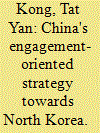| Srl | Item |
| 1 |
ID:
160010


|
|
|
|
|
| Summary/Abstract |
In response to the challenge of unstable North Korea (weak economy, weapons of mass destruction [WMD] development), China has followed an engagement-oriented strategy based on diplomatic persuasion, economic interaction and moderate economic sanctions. Intensified engagement (2009–2012) facilitated North Korean convergence with China in respect of economic reform but divergence has persisted over WMD development. Despite the widening of divergence since 2013, China has refrained from applying crippling sanctions. This article seeks to explain these diverging results and their implications for China's strategy towards North Korea. Reviewing recent literature and data, it will argue that Chinese economic input reinforced the trend of economic reform that formed the basis of political consolidation under the new hereditary regime. On the other hand, the prospect of stable dependence on China ran counter to that regime's pursuit of WMDs as the basis of security and diplomatic diversification. These mixed results reveal the limits of China's strategy: its economic input involuntarily reinforces North Korea's WMD potential but it is not prepared to accept the risks of enforcing WMD restraint by crippling sanctions either. With limited room for manoeuvre, the attainment of China's strategic objectives ultimately depends upon policy change from the US or South Korea.
|
|
|
|
|
|
|
|
|
|
|
|
|
|
|
|
| 2 |
ID:
177666


|
|
|
|
|
| Summary/Abstract |
China’s policy of restraint (avoidance of crippling economic sanctions) towards North Korean provocation is typically explained in terms of geopolitical concern with North Korean regime stability. The strategic and diplomatic costs of restraint would suggest the presence of non-geopolitical influences behind China’s approach. Ideational explanations emphasise the persistence of shared socialist identity as well as the traditional Sino-centric worldview as shaping influences. There is much less detailed analysis of how China views North Korea’s political economic evolution and how this view has changed over time to produce fluctuations in the bilateral relationship. In order to capture China’s motivations more fully, I introduce two additional variables, namely China’s view of the state of its own reform path (which provides the domestic context shaping policy towards North Korea), and the extent of North Korea’s readiness to prioritise economic reform. I will then use these variables to explain two contrasting phases which represented the worst (1992–1999) and best (2009–2012) of times in the bilateral relationship in the post-Cold War era. These variables also help us to understand the potentials and limitations of the upturn in bilateral relations which has occurred since 2018.
|
|
|
|
|
|
|
|
|
|
|
|
|
|
|
|